Agribusiness
Agribusiness is the
in which case it is also called bio-business[4][5] or bio-enterprise. The primary goal of agribusiness is to maximize profit while satisfying the needs of consumers for products related to natural resources such as biotechnology, farms, food, forestry, fisheries, fuel, and fiber.Studies of business growth and performance in farming have found successful agricultural businesses are cost-efficient internally and operate in favorable economic, political, and physical-organic environments. They are able to expand and make profits, improve the productivity of land, labor, and capital, and keep their costs down to ensure market price competitiveness.[6]
Agribusiness is not limited to farming. It encompasses a broader spectrum through the agribusiness system which includes input supplies,
.In some countries like the Philippines, creation and management of agribusiness enterprises require consultation with registered agriculturists above a certain level of operations, capitalization, land area, or number of animals in the farm.
Evolution of the agribusiness concept
The word "agribusiness" is a
"Agribusiness is the sum total of all operations involved in the manufacture and distribution of farm supplies; production operations on the farm; and the storage, processing, and distribution of farm commodities and items made from them." (Davis and Goldberg, 1956)
Their book argued against the
Mark R. Edwards and Clifford J. Shultz II (2005) of
"Agribusiness is a dynamic and systemic endeavor that serves consumers globally and locally through innovation and management of multiple value chains that deliver valued goods and services derived from sustainable orchestration of food, fiber and natural resources." (Edwards and Shultz, 2005)
In 2012, Thomas L. Sporleder and Michael A. Boland defined the unique economic characteristics of agribusiness supply chains from industrial manufacturing and service supply chains.[16] They have identified seven main characteristics:
- Risks emanating from the biological nature of agrifood supply chains
- The role of buffer stockswithin the supply chain
- The scientific foundation of innovation in production agriculture having shifted from chemistry to biology
- Cyberspace and information technology influences on agrifood supply chains
- The prevalent market structure at the farm gate remains oligopsony
- Relative market power shifts in agrifood supply chains away from food manufacturers downstream to food retailers
- Globalization of agriculture and agrifood supply chains
In 2017, noting the rise of genetic engineering and biotechnology in agriculture, Goldberg further expanded the definition of agribusiness which covers all the interdependent aspects of the food system including medicine, nutrition, and health.[1] He also emphasized the responsibility of agribusiness to be environmentally and socially conscious towards sustainability.[17]
"Agribusiness is the interrelated and interdependent industries in agriculture that supply, process, distribute, and support the products of agriculture." (Goldberg, 2017)
Some agribusinesses have adopted the triple bottom line framework such as aligning for fair trade, organic, good agricultural practices, and B-corporation certifications towards the concept of social entrepreneurship.
Agribusiness System
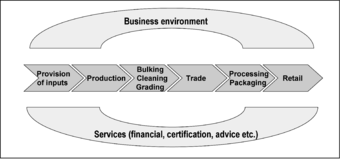
The term value chain was first popularized in a book published in 1985 by Michael Porter,[18] who used it to illustrate how companies could achieve what he called “competitive advantage” by adding value within their organization. Subsequently, the term was adopted for agricultural development purposes [19] and has now become very much in vogue among those working in this field, with an increasing number of bilateral and multilateral aid organisations using it to guide their development interventions.
At the heart of the agricultural value chain concept is the idea of actors connected along a chain producing and delivering goods to consumers through a sequence of activities.[20] However, this “vertical” chain cannot function in isolation and an important aspect of the value chain approach is that it also considers “horizontal” impacts on the chain, such as input and finance provision, extension support and the general enabling environment. The approach has been found useful, particularly by donors, in that it has resulted in a consideration of all those factors impacting on the ability of farmers to access markets profitably, leading to a broader range of chain interventions. It is used both for upgrading existing chains and for donors to identify market opportunities for small farmers.[21]Inputs Sector
Agricultural supplies
An agricultural supply store or agrocenter is an
Agricultural labor
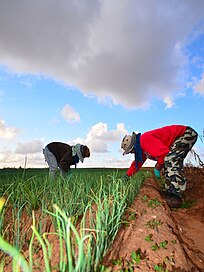

A farmworker, farmhand or agricultural worker is someone employed for labor in agriculture. In labor law, the term "farmworker" is sometimes used more narrowly, applying only to a hired worker involved in agricultural production, including harvesting, but not to a worker in other on-farm jobs, such as picking fruit.
Agricultural work varies widely depending on context, degree of mechanization and crop. In countries like the United States where there is a declining population of American citizens working on farms — temporary or itinerant skilled labor from outside the country is recruited for labor-intensive crops like vegetables and fruits.
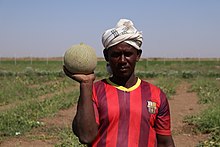

Irrigation
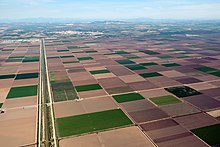
There are several methods of irrigation that differ in how water is supplied to plants. Surface irrigation, also known as gravity irrigation, is the oldest form of irrigation and has been in use for thousands of years. In sprinkler irrigation, water is piped to one or more central locations within the field and distributed by overhead high-pressure water devices. Micro-irrigation is a system that distributes water under low pressure through a piped network and applies it as a small discharge to each plant. Micro-irrigation uses less pressure and water flow than sprinkler irrigation. Drip irrigation delivers water directly to the root zone of plants. Subirrigation has been used in field crops in areas with high water tables for many years. It involves artificially raising the water table to moisten the soil below the root zone of plants.
Irrigation water can come from
Seeds
Seed companies produce and sell seeds for flowers, fruits and vegetables to commercial growers and amateur gardeners. The production of seed is a multibillion-dollar global business, which uses growing facilities and growing locations worldwide. While most of the seed is produced by large specialist growers, large amounts are also produced by small growers who produce only one to a few crop types. The larger companies supply seed both to commercial resellers and wholesalers. The resellers and wholesalers sell to vegetable and fruit growers, and to companies who package seed into packets and sell them on to the amateur gardener.
Most seed companies or resellers that sell to retail produce a catalog, for seed to be sown the following spring, that is generally published during early winter. These catalogs are eagerly awaited by the amateur gardener, as during winter months there is little that can be done in the garden so this time can be spent planning the following year’s gardening. The largest collection of nursery and seed trade catalogs in the
Fertilizers

A
Historically fertilization came from natural or organic sources: compost, animal manure, human manure, harvested minerals, crop rotations and byproducts of human-nature industries (i.e. fish processing waste, or bloodmeal from animal slaughter). However, starting in the 19th century, after innovations in plant nutrition, an agricultural industry developed around synthetically created fertilizers. This transition was important in transforming the global food system, allowing for larger-scale industrial agriculture with large crop yields.
Production Sector
Farming
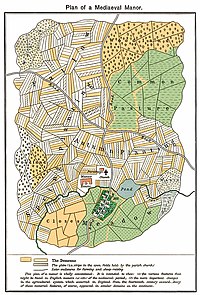
A farm (also called an agricultural holding) is an area of land that is devoted primarily to agricultural processes with the primary objective of producing food and other crops; it is the basic facility in food production.[27] The name is used for specialized units such as arable farms, vegetable farms, fruit farms, dairy, pig and poultry farms, and land used for the production of natural fiber, biofuel, and other commodities. It includes ranches, feedlots, orchards, plantations and estates, smallholdings, and hobby farms, and includes the farmhouse and agricultural buildings as well as the land. In modern times, the term has been extended so as to include such industrial operations as wind farms and fish farms, both of which can operate on land or at sea.
There are about 570 million farms in the world, most of which are small and family-operated. Small farms with a land area of fewer than 2 hectares operate on about 12% of the world's agricultural land, and family farms comprise about 75% of the world's agricultural land.[28]
Modern farms in developed countries are highly mechanized. In the United States, livestock may be raised onFarm Mechanization

Agricultural engineering, also known as agricultural and biosystems engineering, is the field of study and application of engineering science and designs principles for agriculture purposes, combining the various disciplines of mechanical, civil, electrical, food science, environmental, software, and chemical engineering to improve the efficiency of farms and agribusiness enterprises[29] as well as to ensure sustainability of natural and renewable resources.[30]
An agricultural engineer is an engineer with an agriculture background. Agricultural engineers make the engineering designs and plans in an agricultural project, usually in partnership with an agriculturist who is more proficient in farming and agricultural science.Processing Sector
Primary Processing

Primary food processing turns agricultural products, such as raw
Contamination and spoilage problems in primary food processing can lead to significant public health threats, as the resulting foods are used so widely.[32] However, many forms of processing contribute to improved food safety and longer shelf life before the food spoils.[33] Commercial food processing uses control systems such as hazard analysis and critical control points (HACCP) and failure mode and effects analysis (FMEA) to reduce the risk of harm.[32]Secondary Processing

Marketing Sector
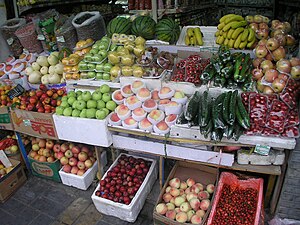
Farmers' Market
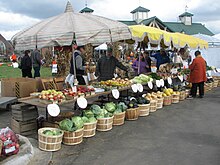
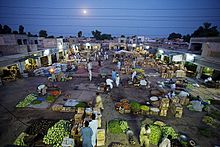

A
Support Sector
Education
Extension practitioners can be found throughout the world, usually working for government agencies. They are represented by several professional organizations, networks and extension journals.
Agricultural extension agencies inCooperatives

An
A broad typology of agricultural cooperatives distinguishes between agricultural service cooperatives, which provide various services to their individually-farming members, and agricultural production cooperatives in which production resources (land, machinery) are pooled and members farm jointly.[43]
Notable examples of agricultural cooperatives include Dairy Farmers Of America, the largest dairy company in the US,[44] Amul, the largest food product marketing organization in India[45] and Zen-Noah, a federation of agricultural cooperatives that handles 70% of the sales of chemical fertilizers in Japan.[46]
The default meaning of "agricultural cooperative" in English is usually an agricultural service cooperative, the numerically dominant form in the world. There are two primary types of agricultural service cooperatives: supply cooperatives and marketing cooperatives. Supply cooperatives supply their members with inputs for agricultural production, includingGovernments


The Food and Agriculture Organization of the United Nations[47] (FAO) is a specialized agency of the United Nations that leads international efforts to defeat hunger and improve nutrition and food security. Its Latin motto, fiat panis, translates to "let there be bread". It was founded on 16 October 1945.[48]
The FAO comprises 195 members, including 194 countries and the European Union. Its headquarters is in Rome, Italy, and it maintains regional and field offices worldwide, operating in over 130 countries.[49] It helps governments and development agencies coordinate their activities to improve and develop agriculture, forestry, fisheries, and land and water resources. It also conducts research, provides technical assistance to projects, operates educational and training programs, and collects agricultural output, production, and development data.[49]
The FAO is governed by a biennial conference representing each member country and the European Union, which elects a 49-member executive council.[50] The Director-General, as of 2019 Qu Dongyu of China, serves as the chief administrative officer.[51] Various committees govern matters such as finance, programs, agriculture, and fisheries.[52]
| 100 lire (FAO's celebration.) | |
|---|---|

| |
| Obverse: Young woman with braid facing left. Surrounded by Repubblica Italiana [Italian Republic]. | Reverse: Cow nursing calf, face value & date. FAO at bottom and Nutrire il Mondo [Feed the world] at top. |
| Coined minted by Italy in 1970s to celebrate and promote Food and Agriculture Organization. | |
Professionals
An
The primary role of agriculturists are in leading agricultural projects and programs, usually in agribusiness planning or research for the benefit of farms, food, and agribusiness-related organizations.[54] Agriculturists usually are designated in the government as public agriculturists serving as agriculture policymakers or technical advisors for policy making.[55] Agriculturists can also provide technical advice for farmers and farm workers such as in making crop calendars and workflows to optimize farm production, tracing agricultural market channels,[56] prescribing fertilizers and pesticides to avoid misuse,[57] and in aligning for organic accreditation[58] or the national agricultural quality standards.[59]
Preparation ofStudies and Reports
Studies of agribusiness often come from the academic fields of
The Federation of International Trade Associations publishes studies and reports by FAS and AAFC, as well as other non-governmental organizations on its website.[62]
In their book A Concept of Agribusiness,[8] Ray Goldberg and John Davis provided a rigorous economic framework for the field. They traced a complex value-added chain that begins with the farmer's purchase of seed and livestock and ends with a product fit for the consumer's table. Agribusiness boundary expansion is driven by a variety of transaction costs.[citation needed]
As concern over
See also
- Agrarian law
- Agrarian reform
- Agribusiness in Kenya
- Agricultural machinery industry
- Agricultural marketing
- Agricultural value chain
- Agroecology
- Animal–industrial complex
- Biofuel
- Contract farming
- Energy crop
- Energy law
- Environmental impact of agriculture
- Factory farming
- Industrial agriculture
- Land banking
- Pharming (genetics)
References
Citations
- ^ a b Ward, Natalee (2017-05-25). "Ray Goldberg: The man that coined the term "agribusiness"". www.weeklytimesnow.com.au. Archived from the original on 2021-05-02. Retrieved 2021-05-02.
- ^ a b Ng, Desmond; Siebert, John W. (2009). "Toward Better Defining the Field of Agribusiness Management" (PDF). International Food and Agribusiness Management Review. 12 (4).
- S2CID 234433508.
- S2CID 156714858.
- ^ "Curriculum|TOKYO UNIVERSITY OF AGRICULTURE". www.nodai.ac.jp. Retrieved 2021-05-02.
- ^ "Agricultural businesses: Key influences on growth and performance", in Agricultural Businesses: Their Growth & Performance, ISR/Google Books, 2022. ISBN 9780906321782
- ISBN 978-1-895021-81-3.
- ^ ISBN 9781684225248.
- ^ S2CID 157756414.
- ^ a b "Academic Programs". 2015-05-03. Archived from the original on 2015-05-03. Retrieved 2021-05-02.
- ^ a b Desai, D.K. (October 1974). "Evolution of a Concept of Agribusiness and its Application" (PDF). Indian Journal of Agricultural Economics. XXIX (4): 32–43.
- ^ "Department of Agribusiness Management and Entrepreneurship". College of Economics and Management. 14 November 2019. Retrieved 2021-05-02.
- ISBN 978-92-833-1009-9.
- ^ Desai, D. K. (August 1973). "Planning a Progressive Agricultural Infrastructure". 1973 Conference, August 19–30, 1973, São Paulo, Brazil.
- ^ Shultz, Clifford J.; Edwards, Mark R. "Reframing Agribusiness: Moving from Farm to Market Centric". Journal of Agribusiness. 23 (1): 57–73.
- ^ Sporleder, Thomas L.; Boland, Michael A. (2011). "Exclusivity of Agrifood Supply Chains: Seven Fundamental Economic Characteristics" (PDF). International Food and Agribusiness Management Review. 14: 27–52.
- ^ HBS Professor Ray Goldberg on the History of Sustainable Agribusiness, archived from the original on 2021-12-12, retrieved 2021-05-02
- ISBN 978-0684841465.
- ^ Kaplinsky, R.; Morris, M. "A Handbook for Value Chain Analysis" (PDF). IDRC. Archived from the original (PDF) on 1 March 2014. Retrieved 24 February 2014.
- ^ Henriksen, L.; L. Riisgaard; S. Ponte; F. Hartwich; P. Kormawa. "Agro-Food Value Chain Interventions in Asia: A review and analysis of case studies. Working Paper" (PDF). UNIDO. Archived from the original (PDF) on 1 March 2014. Retrieved 24 February 2014.
- ^ "Editorial: Adding Value, by Michael Hailu, Spore No 157". Archived from the original on 2021-02-26. Retrieved 2014-02-25.
- ISSN 1684-8241.
- National Agricultural Library, Special Collections. Retrieved April 23, 2009.
- ISBN 978-3527306732.
- ^ "Fritz Haber". Science History Institute. 2016-06-01. Retrieved 2022-12-16.
- ^ Mbow et al. 2019.
- ^ Gregor, 209; Adams, 454.
- .
- ^ "ASABE". www.asabe.org. Retrieved 2018-04-13.
- ^ "Agricultural and Biosystems Engineering | Professional Regulation Commission". www.prc.gov.ph. Retrieved 2021-05-01.
- ISBN 9780128114995.
- ^ ISBN 9783319601113.
- ^ ISBN 9781771884112.
- ^ ISBN 9781428922792.
- ISBN 9781439836835.
- ^ "AP Style tip: farmers market or farmer's market?". Twitter. AP Stylebook. 30 April 2014. Archived from the original on 3 September 2021. Retrieved 30 January 2022.
- ^ "AP Style tip: farmers market or farmer's market?". Facebook. AP Stylebook. 30 April 2014. Retrieved 30 January 2022.
- Cambridge Dictionary. 30 January 2022. Archivedfrom the original on 30 January 2022. Retrieved 30 January 2022.
- Cambridge Dictionary. 30 January 2022. Archivedfrom the original on 20 January 2022. Retrieved 30 January 2022.
- ^ Denne, Luke; Foxcroft, Tiffany (29 September 2017). "'People are being duped': CBC exposes homegrown lies at farmers markets". CBC News. Canadian Broadcasting Corporation. Archived from the original on 10 October 2019. Retrieved 15 November 2017.
- ^ Bell, Randy (29 August 2013). "Public markets differ from farmers markets". MSU Extension. Michigan State University. Archived from the original on 26 February 2018. Retrieved 11 January 2021.
- ^ "The Difference Between Public Markets and Farmers Markets". Charlotte, NC USA: 7th Street Public Market. Archived from the original on 7 April 2014.
- ^ Cobia, David, editor, Cooperatives in Agriculture, Prentice-Hall, Englewood Cliffs, NJ (1989), p. 50.
- ^ "Dairy Industries International" (PDF).
- ^ "India's Amul: Keeping Up with the Times - Case - Faculty & Research - Harvard Business School". www.hbs.edu. Retrieved 2024-02-01.
- ^ Béla A. Balassa; Marcus Noland. Japan in the World Economy. p. 228.
- ^ French: Organisation des Nations unies pour l'alimentation et l'agriculture; Italian: Organizzazione delle Nazioni Unite per l'alimentazione e l'agricoltura.
- ^ "Food and Agriculture Organization | United Nations organization". Encyclopedia Britannica. Retrieved 31 December 2019.
- ^ a b "About FAO". Food and Agriculture Organization of the United Nations. Retrieved 31 December 2019.
- ^ "List of FAO members". fao.org. Archived from the original on 20 August 2019. Retrieved 15 October 2010.
- ^ "Leadership | Food and Agriculture Organization of the United Nations". www.fao.org. Retrieved 31 December 2019.
- ^ "GSB: Home page". www.fao.org. Retrieved 31 December 2019.
- ^ "Agriculturist". ble.dole.gov.ph. Archived from the original on 2021-04-30. Retrieved 2021-04-30.
- ^ "Agriculture | Professional Regulation Commission". www.prc.gov.ph. Retrieved 2021-04-30.
- ^ "Qualification Standards for Agriculturist Position" (PDF). Civil Service Commission. Archived (PDF) from the original on 2016-06-15.
- ^ "Agribusiness and Marketing Assistance". Department of Agriculture. Archived from the original on 2017-07-06.
- ^ "PD 1144 - Fertilizer and Pesticide Authority". fpa.da.gov.ph. Retrieved 2021-05-02.
- ^ "Organic Agriculture Program". Archived from the original on 2018-09-07.
- ^ "BAFS | Bureau of Agriculture and Fisheries Standards". 2021-01-18. Archived from the original on 2021-01-18. Retrieved 2021-05-02.
- ^ "Agricultural and Biosystems Engineering | Professional Regulation Commission". www.prc.gov.ph. Retrieved 2021-05-02.
- ^ "Rural Planning". Queensland Farmers' Federation. 2016-11-01. Retrieved 2021-11-19.
- ^ "What is Agribusiness in 2023". farmingagri.com. Archived from the original on 2018-06-27. Retrieved 2013-05-02.
- ^ "Backpedaling on Biofuels". Wild.org. 2008-08-01. Archived from the original on 2012-09-19. Retrieved 2013-05-02.
Cited sources
- Mbow, Cheikh; Rosenzweig; Barioni, Luis .G.; Benton, Tim .G. (2019). "Food security". In Shukla, P.R.; Skea, J.; Buendia, E. Calvo; Masson-Delmotte, V. (eds.). Climate Change and Land: an IPCC special report on climate change, desertification, land degradation, sustainable land management, food security, and greenhouse gas fluxes in terrestrial ecosystems. IPCC.
Further reading
- Wilkinson, John. "The Globalization of Agribusiness and Developing World Food Systems". Monthly Review.
- Gitta, Cosmas and South, David (2012). Southern Innovator Magazine Issue 3: Agribusiness and Food Security: United Nations Office for South-South Cooperation. ISSN 2222-9280
- https://web.archive.org/web/20160304034828/http://www.ifama.org/files/IS_Ledesma_Formatted.pdf
